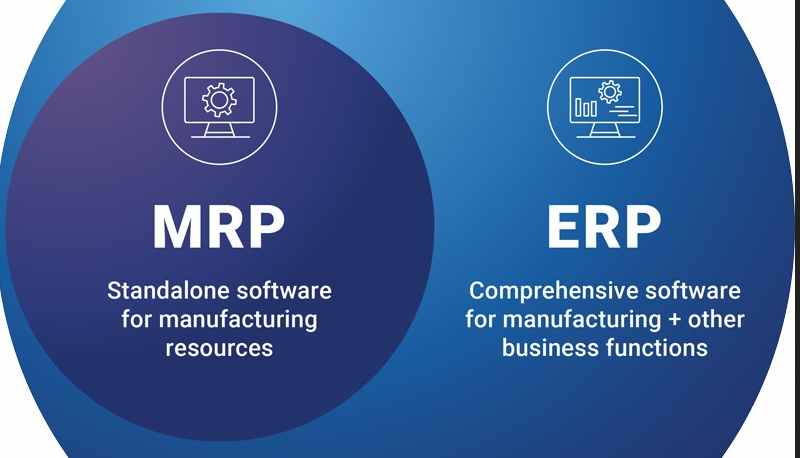In the realm of business management software, Material Requirements Planning (MRP) and Enterprise Resource Planning (ERP) are two essential tools that significantly impact operations, especially in manufacturing and supply chain management. Understanding the differences between MRP and ERP, and how integrating them can enhance efficiency, is crucial for businesses aiming to streamline their processes and improve overall performance. In this comprehensive guide, we will delve into the definitions, key differences, integration benefits, and real-world examples of successful MRP-ERP integration.
Defining MRP and ERP Systems
What is MRP?
Material Requirements Planning (MRP) is a system designed to manage manufacturing processes. It focuses on ensuring that materials are available for production and products are available for delivery to customers. MRP systems help businesses plan production schedules, manage inventory levels, and coordinate manufacturing activities. Key functionalities of MRP include:
- Inventory Control: Tracking raw materials and component inventory.
- Production Planning: Scheduling manufacturing activities to meet customer demands.
- Demand Forecasting: Predicting future material needs based on historical data.
What is ERP?
Enterprise Resource Planning (ERP) is an integrated management system that combines various business processes into a single unified system. Unlike MRP, which primarily focuses on manufacturing, ERP encompasses a broader range of business functions, including finance, human resources, supply chain management, customer relationship management, and more. Key features of ERP systems include:
- Financial Management: Handling accounting, budgeting, and financial reporting.
- Human Resources Management: Managing employee records, payroll, and recruitment.
- Supply Chain Management: Overseeing procurement, inventory, and logistics.
- Customer Relationship Management: Managing customer data, sales, and service.
Key Differences Between MRP and ERP
Scope and Functionality
- Scope: MRP is primarily focused on manufacturing and inventory management, while ERP covers a wider range of business functions, including finance, HR, sales, and supply chain management.
- Functionality: MRP systems provide detailed planning and control of manufacturing processes, whereas ERP systems offer an integrated approach to managing all core business processes.
Integration Capabilities
- Integration: ERP systems are designed to integrate various business processes into a single platform, providing a holistic view of the organization. MRP systems, on the other hand, often operate as standalone solutions or are integrated into larger ERP systems.
- Data Centralization: ERP systems centralize data from different departments, facilitating better decision-making and coordination across the organization. MRP systems typically focus on data related to manufacturing and inventory.
Business Impact
- Manufacturing Efficiency: MRP systems are critical for optimizing manufacturing processes, reducing waste, and ensuring timely production. ERP systems enhance overall business efficiency by integrating and streamlining various functions, leading to improved productivity and cost savings.
- Decision-Making: ERP systems provide comprehensive insights into the entire organization, supporting strategic decision-making. MRP systems offer detailed information about manufacturing operations, aiding tactical decision-making in production planning.
Integration of MRP and ERP for Better Supply Chain Management
Integrating MRP with ERP systems can significantly enhance supply chain management by providing a seamless flow of information across all business functions. Here’s how integration can be achieved:
Data Synchronization
Integrating MRP and ERP systems ensures that data is consistently updated and accessible across different departments. This synchronization helps in maintaining accurate inventory levels, reducing discrepancies, and improving coordination between production and other business functions.
Enhanced Planning and Forecasting
By combining the detailed manufacturing data from MRP with the broader business insights from ERP, organizations can improve their planning and forecasting capabilities. This integration enables more accurate demand forecasting, better production scheduling, and efficient resource allocation.
Streamlined Operations
Integration eliminates the need for manual data entry and reduces the risk of errors. Automated data flow between MRP and ERP systems streamlines operations, reduces administrative overhead, and enhances overall efficiency.
Benefits of Integrating MRP and ERP Systems
Improved Efficiency
Integration leads to improved efficiency by automating processes and reducing manual interventions. This results in faster production cycles, reduced lead times, and increased throughput.
Better Visibility
Organizations gain better visibility into their operations, from procurement to production to sales. This visibility helps in identifying bottlenecks, optimizing processes, and making informed decisions.
Cost Savings
By streamlining operations and improving resource utilization, integration can lead to significant cost savings. Organizations can reduce inventory carrying costs, minimize production delays, and improve profitability.
Enhanced Collaboration
Integration fosters better collaboration between different departments. Teams can access real-time data, coordinate activities, and work towards common goals, leading to a more cohesive and productive organization.
Case Studies and Real-World Examples of Successful MRP-ERP Integration
Case Study 1: Manufacturing Company A
Manufacturing Company A integrated its MRP system with an ERP solution to streamline its operations. The integration enabled the company to synchronize production schedules with sales orders, reduce inventory costs by 20%, and improve on-time delivery rates by 15%. The enhanced visibility into operations also allowed for better decision-making and strategic planning.
Case Study 2: Distribution Company B
Distribution Company B faced challenges in managing its supply chain due to disparate systems. By integrating MRP and ERP systems, the company achieved real-time visibility into inventory levels, improved demand forecasting, and optimized warehouse operations. This integration resulted in a 25% reduction in stockouts and a 30% increase in order fulfillment efficiency.
Conclusion
Understanding the differences between MRP and ERP systems and integrating them can provide significant benefits to businesses. From improved efficiency and cost savings to better visibility and collaboration, the integration of MRP and ERP systems is a strategic move for organizations looking to enhance their supply chain management and overall business performance. By carefully planning the integration process and leveraging the strengths of both systems, businesses can achieve a seamless flow of information and drive success.

